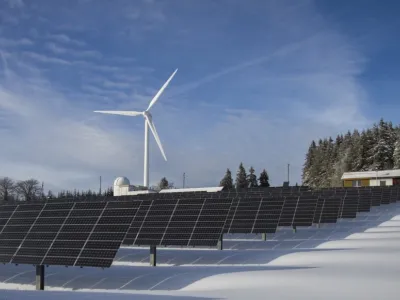Xcel is no longer pursuing gas power plant, proposes more renewable power

Published June 28, 2021. Updated July 7, 2021 with information about comment process.
On Friday, Xcel Energy announced that it was no longer pursuing its proposed natural gas power plant in Sherburne County (the “Sherco plant”). Xcel said it heard strong opposition to the plant (including from CUB) and took another look to find an alternative. Xcel’s new plan will result in lower greenhouse gas emissions from its power generation and includes significantly more wind and solar power than previously proposed. This is a major step forward.
This announcement came in a 237-page Public Utilities Commission (PUC) filing from the utility presenting an alternative to their previously proposed integrated resource plan (IRP). (An IRP is an electric utility’s plan of how an electric utility will get the electricity to supply its customers over the following 15-years.) We are still digging into the details, but there is much that CUB agrees with in the new plan.
The biggest change with Xcel’s new proposal is the elimination of the Sherco plant. This was to be a large (835-megawatt) combined cycle gas plant located at the site of its soon-to-retire Sherco coal plant in Becker, Minnesota. In 2017, Xcel won controversial legislation allowing it to largely circumvent the PUC’s authority to consider whether the plant was the best option, smoothing the way for Xcel to construct it. Modeling conducted in this IRP by CUB, a coalition of Clean Energy Organizations, Sierra Club, and the Minnesota Department of Commerce each – independently – showed that the plant was not the best investment, and in fact could put Xcel customers on the hook for hundreds of millions in unnecessary costs, not to mention greenhouse gas emissions. Several parties commenting on Xcel’s original preferred plan (including CUB) also noted that building a brand new natural gas plant is inconsistent with federal and state emissions reduction goals, and Xcel’s own commitment to produce 100% carbon-free electricity by 2050. Xcel, saying it heard this opposition, is no longer asking for the Sherco plant to be approved.
Instead, Xcel offered an alternative plan that includes a lot more wind and solar generation. It would construct two new in-state transmission lines, which would allow more renewable generation to be interconnected onto its system and the regional grid. It would continue the plan to retire its remaining coal plants by 2030, to substantially invest in energy efficiency, and to continue to operate the two nuclear plants Xcel owns in Minnesota. All of this aligns pretty well with what CUB has recommended.
Xcel also proposes building a lot more natural gas generation capacity in its new plan, but these generators would operate rarely. The new plan proposes two new combustion turbine plants in Lyon County, MN and Fargo, ND. Each plant would have a generating capacity of 400-MW. In addition, Xcel would update two existing combustion turbine plants to keep them operating for years to come. Unlike the Sherco plant, which Xcel estimated would run at 80% of its full capacity, these plants would run only occasionally, averaging a 5% capacity factor. They would be “peakers,” running only occasionally to meet demand peaks. Xcel also notes that it may need substantial additional gas generator capacity down the road, but that need could be met with another type of power resource.
We are still examining the new plan. CUB’s modeling demonstrated that Xcel could reliably meet its customers’ needs without any new gas generation, so we want to take a particularly hard look at the proposed new and refurbished gas plants. Additionally, Xcel’s plan includes very little distributed solar, an important resource for keeping costs and emissions down. And CUB’s modeling found that Xcel could benefit from a significant amount of battery storage; Xcel’s new plan adds a small amount, but not until 2030. Finally, Xcel says that its new plan costs less than its previous plan. This comports with CUB’s modeling, showing that eliminating the Sherco plant would save customers money, but we’d like to better understand Xcel’s calculations and precisely which costs are included (or not).
This new direction is an excellent step for Xcel customers and the environment. However, we recognize that it will be challenging for the workers and surrounding community at the existing Sherco coal plant. The plant employs 300 people at an average salary of over $88,000, and it contributes 77% of the tax base for the city of Becker, according to a study by Center for Energy and Environment. We understand that many in the community had been hopeful that the new gas plant would provide some ongoing plant jobs and property tax revenues, and the new proposal will be seen as a loss to many in the area. Recognizing this, Xcel noted that it is working with stakeholders to attract new economic development to the area and that it guarantees all of its current employees will continue to have jobs, but it will undoubtedly require more effort to help the area transition.
Xcel’s new proposal, like the rest of its resource plan, requires approval by the PUC. The PUC has requested comments on the proposal from parties (like CUB) and the public. Comments will be accepted until 4:30 p.m. on August 13. If you would like to let the PUC know what you think of the plan, here’s how:
| Online: Visit htpps://mn.gov/puc, select Comment, and follow the prompts Email: consumer.puc@state.mn.us Mail: Consumer Affairs Office, Minnesota Public Utilities Commission 121 7th Place East, Suite 350 St. Paul, MN 55101 |
Make sure to reference Docket No. 19-368 in your comment, and please note that anything you include will become part of the public record.
CUB will be submitting comments on the new plan, too, and we will keep you informed of the process going forward.